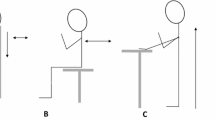Abstract
We describe a novel, brief evaluation of the effects of nonremoval of the cup on the consumption of water in a boy with autism and liquid refusal associated with a feeding disorder. The evaluation demonstrated that nonremoval of the cup, added to noncontingent reinforcement, increased water consumption compared to noncontingent reinforcement alone. This finding replicates prior research and provides practitioners with a brief experimental method for quickly determining a client’s responsiveness to nonremoval of the cup.

Similar content being viewed by others
References
Addison, L. R., Piazza, C. C., Patel, M. R., Bachmeyer, M. H., Rivas, K. M., Milnes, S. M., & Oddo, J. (2012). A comparison of sensory integrative and behavioral therapies as treatment for pediatric feeding disorders. Journal of Applied Behavior Analysis, 45, 455–471. https://doi.org/10.1901/jaba.2012.45-455
DeLeon, I. G., & Iwata, B. A. (1996). Evaluation of a multiple-stimulus presentation format for assessing reinforcer preferences. Journal of Applied Behavior Analysis, 29, 519–533. https://doi.org/. https://doi.org/10.1901/jaba.1996.29-519.
Groff, R. A., Piazza, C. C., Zeleny, J. R., & Dempsey, J. R. (2011). Spoon-to-cup fading as treatment for cup drinking in a child with intestinal failure. Journal of Applied Behavior Analysis, 44, 949–954. https://doi.org/10.1901/jaba.2011.44-949.
Hoch, T. A., Babbitt, R. L., Coe, D. A., Krell, D. M., & Hackbert, L. (1994). Contingency contacting: Combining positive reinforcement and escape extinction procedures to treat persistent food refusal. Behavior Modification, 18, 106–128.
Kadey, H. J., Roane, H. S., Diaz, J. C., & McCarthy, C. M. (2013). Using a Nuk® brush to increase acceptance of solids and liquids for two children diagnosed with autism. Research in Autism Spectrum Disorders, 7, 1461–1480. https://doi.org/10.1016/j.rasd.2013.07.017
Kahathuduwa, C. N., West, B. D., Blume, J., Dharavath, N., Moustaid-Moussa, N., & Mastergeorge, A. (2019). The risk of overweight and obesity in children with autism spectrum disorders: A systematic review and meta-analysis. Pediatric Obesity. Advance online publication. https://doi.org/. https://doi.org/10.1111/obr.12933.
Kozlowski, A. M., Taylor, T., Pichardo, D., & Girolami, P. A. (2016). The impact of emerging liquid preference in the treatment of liquid refusal. Journal of Developmental and Physical Disabilities, 28, 443–460. https://doi.org/10.1007/s10882-016-9482-4
Peterson, K. M., Volkert, V. M., & Milnes, S. M. (2017). Evaluation of practice trials to increase self-drinking in a child with a feeding disorder. Behavior Analysis in Practice, 10, 167–171. https://doi.org/10.1007/s40617-016-0147-7
Piazza, C. C., Fisher, W. W., Brown, K. A., Shore, B. A., Patel, M. R., Katz, R. M., . . . Blakely-Smith, A. (2003). Functional analysis of inappropriate mealtime behaviors. Journal of Applied Behavior Analysis, 36, 187–204. https://doi.org/10.1901/jaba.2003.36-187
Silbaugh, B. C., Penrod, B., Whelan, C. M., Hernandez, D. A., Wingate, H. V., Falcomata, T. S., & Lang, R. (2016). A systematic synthesis of behavioral interventions for food selectivity of children with autism spectrum disorders. Review Journal of Autism and Developmental Disorders, 3, 345–357. https://doi.org/10.1007/s40489-016-0087-8
Author information
Authors and Affiliations
Corresponding author
Ethics declarations
Conflict of Interest
The authors declare that they have no conflict of interest.
Ethical Approval
All procedures performed in studies involving human participants were in accordance with the ethical standards of the institutional and/or national research committee and with the 1964 Helsinki declaration and its later amendments or comparable ethical standards.
Informed Consent
Informed consent was obtained from all individual participants included in the study.
Additional information
Publisher’s Note
Springer Nature remains neutral with regard to jurisdictional claims in published maps and institutional affiliations.
We thank the family for participating in our research.
Research Highlights
• Nonremoval of the cup increases liquid consumption in some children with feeding disorders.
• A brief multielement design comparing noncontingent reinforcement sessions with and without nonremoval of the cup may be used to initially determine the likelihood of increased water consumption for a given client.
• An empty cup is a useful indirect measure of drinking.
• Inappropriate mealtime behavior may occur during the evaluation despite increased drinking and should guide subsequent treatment planning.
Rights and permissions
About this article
Cite this article
Silbaugh, B.C., Corley, E.A. & Maldonado, J. Brief Experimental Evaluation of Nonremoval of the Cup to Increase Water Consumption. Behav Analysis Practice 13, 679–683 (2020). https://doi.org/10.1007/s40617-020-00420-3
Published:
Issue Date:
DOI: https://doi.org/10.1007/s40617-020-00420-3




